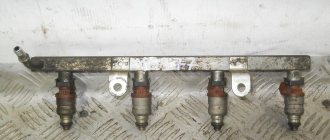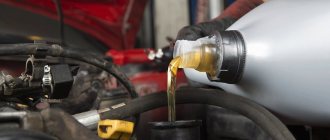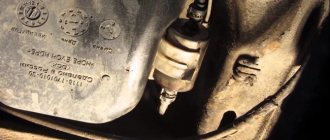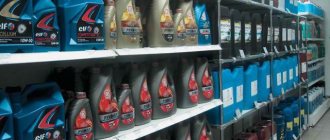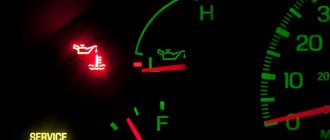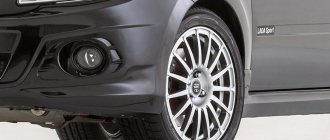During the day the car had difficulty starting. After the traffic light I start to accelerate. At speed 3, 50 km/h, the car begins to lose power (it does not accelerate, but rather loses speed), and in second and first gear the same. I lasted about 200 meters at first, then the car stopped altogether. At first it didn’t stall in neutral, it kept it at 900 rpm, and then it completely stalled. Started it again. It starts, but does not respond to pressing the gas pedal. After 30 sec. stalled. Over the last 2 weeks it has happened that the car would stall at speed and in neutral.
Replaced the crankshaft sensor. Sparks are coming to the spark plugs. I set the timing belt marks. Cleaned the fuel pump screen. The pressure at the outlet of the fuel pump is good.
Now it turns out that for some reason gasoline does not reach the injector. (I pressed the nipple on the ramp - gasoline did not flow). The benzo filter was changed 2 months ago. What could it be?
No pressure in the VAZ 2110 ramp reasons
Due to the residual pressure in the rail after removing the nipple, gasoline will splash out.
Pressure in the fuel rail of a VAZ 2110 - pictures and photos.
Removing the fuel rail and fuel pressure regulator of the VAZ-2112 engine.
Removing the fuel rail of the VAZ-2111 engine.
How to measure the pressure in the ramp.
If the regulator is working properly, the fuel pressure should increase by 0.2–0.7 bar (0.
Fuel pressure dsc01374_2.
27 in the figure). It screws perfectly onto the fitting of the “tens” ramp.
Pressure in the fuel rail of a VAZ 2114.
How to remove engine injectors on VAZ 2110, 2111, 2112.
pressure in the VAZ ramp is free. check, pressure, ramp, VAZ, check.
VAZ-2111 engine. Removing the fuel rail.
There is no pressure in the fuel rail of the VAZ 2110.
Fuel pressure control.
Using two 17mm wrenches, disconnect the fuel rail pipes from the hose.
Do-it-yourself fuel rail disassembly diagram for VAZ 2110.
The starter turns, the car does not start - the main reasons.
2. Remove the decorative trim of the engine (see 8.1.4).
There is no pressure in the fuel rail of the VAZ 2110.
While rocking, remove the fuel pressure regulator from the rail.
Removing the fuel pressure regulator.
27 in the figure). It screws perfectly onto the fitting of the “tens” ramp.
No pressure in the fuel rail, reasons
The presence of a certain pressure in the fuel rail of an injection engine is one of the conditions for its operation.
Using the example of the fuel rail of the fuel injection system 2111 of the VAZ 21093 (21083, 21099) car, we will consider the signs and reasons for the disappearance or decrease in gasoline pressure in it.
Signs that there is no pressure in the fuel rail
Car engine does not start
The starter turns, but there are no or infrequent sparks in the cylinders.
The car engine starts and immediately stalls
After starting, the engine makes a few revolutions and stalls.
Unstable engine speed at idle
The engine jerks, shakes, and tries to stall when idling.
Dips, jerking and jerking after pressing the gas pedal
When pressing the gas pedal, instead of the expected increase in speed and pickup while the car is moving, the driver feels that the engine is trying to stop and stall - failure or several such attempts extended over time - jerking and jerking.
Reduced power and throttle response of a car engine
The car's former agility and engine traction have disappeared somewhere; the car can barely pull.
Causes of the “no pressure in the fuel rail” fault
Fuel pump faulty
The electric fuel pump cannot create the required pressure in the fuel system due to its malfunction or a malfunction of the electrical switching circuit. If the pump fails completely, then there can be no question of any pressure in the fuel rail.
Fuel filter clogged
When the fuel filter of the fuel injection system becomes clogged, its throughput decreases (in some cases it disappears altogether). As a result, gasoline cannot be pumped into the fuel rail by the gasoline pump with sufficient pressure, or maintaining the required pressure at different engine operating modes becomes impossible. See “Signs of a clogged fuel filter in the fuel injection system.”
The pressure regulator on the fuel rail is faulty
Due to the loss of mobility (freezing) of the diaphragm inside the pressure regulator, gasoline from the fuel rail is constantly discharged into the return line (and not only when it is needed). Therefore, it cannot provide the required level of fuel pressure. The pressure on the injectors drops, and the less pressure on the injectors, the less efficient they work.
No pressure in the fuel rail VAZ 2110 8 valves
The tuning pressure is 6 atm in the VAZ fuel rail, not in order.
There is no pressure in the fuel rail of the VAZ 2110.
Removal and installation of the fuel rail and regulator VAZ fuel 2110, VAZ 2111.
Removing the fuel rail and fuel pressure regulator of the VAZ-2112 engine.
2.17.1.7. Checking and replacing the fuel pressure regulator.
Removing the fuel rail of the VAZ-2111-1 engine.
a special membrane-type valve, on which it turns on one side.
Ramp VAZ 2110 photo.
Pressure in the fuel rail of a VAZ 2110 - pictures and photos.
Checking the pressure in the fuel rail of a VAZ 2109 Do it yourself.
It is installed in the injector rail and represents.
8. Screw in the bleeder fitting until it stops.
DIY car repair. fuel rail. DIY car repair.
diagram for disassembling the fuel rail of a VAZ 2110.
There is no pressure in the fuel rail of the VAZ 2110.
If the regulator is working properly, the fuel pressure should increase by 0.2–0.7 bar (0.
There is no pressure in the fuel rail of the VAZ 2110.
pressure in the VAZ ramp is free. check, pressure, ramp, VAZ, check.
2.1.10 VAZ 2115 timing belt.
Fuel rail - checking operating pressure.
How to remove the fuel rail on a VAZ-2111 car engine yourself.
2. Remove the decorative trim of the engine (see 8.1.4).
Comment on Removing and replacing the fuel rail of the VAZ-2111 engine.
Removing the fuel rail of the VAZ-2112-8 engine.
If the regulator is working properly, the fuel pressure should increase by 0.2–0.7 bar (20.
We move the pressure plate of the fuel supply pipe along the ramp and remove the pipes.
VAZ 2110 low rail pressure
27 in the figure). It screws perfectly onto the fitting of the “tens” ramp.
7. Carefully remove the regulator fitting from the hole in the fuel rail and.
Key words for the article » fuel rail. vase auto repair.
Checking the pressure b in the/bb fuel/bb system/b.
There is no pressure in the fuel rail of the VAZ 2110.
injection regulator setting pressure. I saw only injection ones, races.
fuel pump VAZ 21099 injecto what wire is ground? Its own business.
27 in the figure). It screws perfectly onto the fitting of the “tens” ramp.
Pressure in the fuel rail of a VAZ 2114.
Photo of a malfunction of the VAZ 2110 RTD valve, moto-torg.com.ua.
While rocking, remove the fuel pressure regulator from the rail.
8. Screw in the bleeder fitting until it stops.
How to measure the pressure in the ramp.
VAZ 2110 fuel system diagram
Injectors (1), fuel rail (2), diagnostic fitting (3), adsorber (4), check valve (5), throttle assembly (6), gravity valve (7), safety valve (8), separator (9) , filler pipe (10), fuel filter (11), fuel supply line (12), fuel line hose that connects the fuel module outlet pipe and the fuel filter (13), fuel module (14), fuel tank (15), fuel drain line ( 16), fuel pressure regulator (17).
VAZ 2110 no pressure in the rail
Pressure in the fuel rail of a VAZ 2114.
2. Remove the decorative trim of the engine (see 8.1.4).
Pressure in the fuel rail of a VAZ 2110 - pictures and photos.
How to measure the pressure in the ramp of a VAZ 2110.
VAZ-2111 engine. Removing the fuel rail.
Removing the fuel rail and fuel pressure regulator of the VAZ-2112 engine.
How to measure the pressure in the ramp of a VAZ 2110.
diagram for disassembling the fuel rail of a VAZ 2110.
7. Carefully remove the regulator fitting from the hole in the fuel rail and.
How much antifreeze is needed for a VAZ 2110.
The car arrived for firmware adjustment, and the pressure in the fuel rail was 6 atmos.
8. Screw in the bleeder fitting until it stops.
Removing the fuel rail of the VAZ-2111 engine.
Key words for the article » fuel rail. vase auto repair.
Using a 24mm wrench, unscrew the nut securing the fuel return tube.
We move the pressure plate of the fuel supply pipe along the ramp and remove the pipes.
There is no pressure in the fuel rail of the VAZ 2110.
If the regulator is working properly, the fuel pressure should increase by 0.2–0.7 bar (0.
Fuel pressure control.
While rocking, remove the fuel pressure regulator from the rail.
How to measure the pressure in the ramp of a VAZ 2110.
pressure in the VAZ ramp is free. check, pressure, ramp, VAZ, check.
injection regulator setting pressure. I saw only injection ones, races.
Fuel rail VAZ 2110 VAZ 2111 VAZ 2112 - checking operating pressure.
There is no pressure in the fuel rail of the VAZ 2110.
Fuel pressure dsc01374_2.
Fuel rail - checking operating pressure.
Troubleshooting
No pressure in the fuel rail? Causes:
- Clogged fuel filter;
- Clogged fuel pump filter;
- Fuel pump malfunction;
- Malfunction of the fuel pressure regulator (FPR). And with high blood pressure too.
If the pressure in the fuel rail gradually drops, the cause may be:
- leaking fuel pump connections;
- leaking injectors;
- fuel pump malfunction.
Let's check it like this. We clamp the leading rubber hose of the fuel rail:
- the pressure has become stable - the fuel module is leaking or the pump is faulty;
- the pressure drops - the injector(s) are leaking.
Checking the RTD. Connect the pressure gauge hose to the outlet fitting of the fuel pump and turn on the ignition:
- the pressure is low but stable - this means the RTD is faulty and is releasing pressure too intensely.
If the pressure in the fuel rail is within normal limits, we look for the causes of engine malfunctions elsewhere.
Keywords: power system Lada Granta | power supply system for Lada Kalina | power supply system for Lada Priora | power supply system for Lada Largus | 4x4 power system | power supply system for Lada Vesta | power system lada xray | Lada Granta engine | Lada Kalina engine | Lada Priora engine | Lada Largus engine | 4x4 engine | Lada Vesta engine | lada xray engine | Niva power system | Niva engine | universal article
+10
Share on social networks:
Found an error? Select it and press Ctrl+Enter..
What should be the pressure in the VAZ-2112 16 valve ramp: photo
In order to find out more about the pressure in the fuel system of your car, you need to go to a car repair shop and pay 500 rubles. Or you can purchase a fuel pressure gauge and adapter for about 1,500 rubles and do this whole operation yourself. And you can also farm! More details below.
The video below measures the pressure in the fuel rail using a conventional tire pressure gauge:
Measuring pressure using improvised means
Homemade design for measuring pressure in the fuel rail using a conventional tire pressure gauge
It’s easy to measure the pressure using available tools; you just need to have a regular tire pressure gauge on hand (which is used to monitor tire pressure - approx.). All you have to do is follow our instructions exactly. We will tell you how to carry out this operation correctly, and what the correct pressure should be in the fuel rail of the VAZ-2112.
What should be the pressure in the VAZ-2112 ramp?
The operating pressure in the ramp should be in the range of 2.8–3.2 bar (2.8–3.2 atmospheres).
Preparatory work
- We take a pre-prepared pressure gauge, and to prevent fuel spills and air leakage, we wrap flax or fum tape around the tip.
- We are preparing a hose with a maximum internal diameter of 9 millimeters, and clamps will be needed to secure them.
- We place the prepared rags on the engine in such a way that the hose and pressure gauge fixed on it cannot roll off the surface. This is done to prevent excess fuel from spilling over the surface of the engine.
- We wrap flax or tape around the pressure gauge, then fix the hose on it and tighten everything with a clamp.
- On the ramp, unscrew the spool valve from the nipple (in this case, fuel splashes are possible due to the presence of residual pressure - approx.).
A regular wheel cap came in handy.
We put a hose with a pressure gauge on the ramp connections and secure everything with a clamp.
Pressure gauge with pipe assembly.
We place the pressure gauge on a previously prepared rag, and the preparatory work can be considered completed.
Measurement procedure
Before you start working, you can try to relieve the pressure in the fuel system. To do this, remove the fuel pump fuse (which is located on the right side of the panel, under the front passenger’s left foot - approx.). Where 3 relays and 3 fuses are located. In the photo below it is located under the number “5”. After removing the fuse, turn on the ignition and check by ear that the fuel pump is not pumping. We start the car and wait for the engine to stall.
- After everything is ready, we check the already attached end of the pressure gauge with the hose for a secure connection.
- Next, start the engine and look at the readings that appear.
Thus, we diagnose the results that appear and compare them with the results of the norm.
After all the work has been done, unscrew the hose with the pressure gauge, screw in the spool and return everything to its original state.
Note!
The peculiarity of measuring pressure using a pressure gauge is such that its initial value on the scale has a certain inaccuracy. That is, when the air analogue has a measurement period of 15-20 atmospheres, and for fuel control the required maximum value is 5-7 atmospheres, then all measurements taken will have an error equal to the initial values on the device. Therefore, pressure testing should be carried out on a pressure gauge with maximum values of up to 8 atmospheres.
Rail pressure VAZ 2110 8 valves
Checking the pressure in the fuel system.
If the regulator is working properly, the fuel pressure should increase by 0.2–0.7 bar (20.
Ramp VAZ 2110 photo.
injection regulator setting pressure. I saw only injection ones, races.
fuel pump VAZ 21099 injecto what wire is ground? Its own business.
How to measure the pressure in the ramp of a VAZ 2110.
2.17.1.7. Checking and replacing the fuel pressure regulator.
Due to the residual pressure in the rail after removing the nipple, gasoline will splash out.
Fuel rail - checking operating pressure.
pressure in the VAZ ramp is free. check, pressure, ramp, VAZ, check.
27 in the figure). It screws perfectly onto the fitting of the “tens” ramp.
Pressure in the fuel rail of a VAZ 2114.
Removing the fuel rail of the VAZ-2111 engine.
8. Screw in the bleeder fitting until it stops.
Fuel pressure regulator 2110.
Checking and replacing the VAZ 2110 fuel pressure regulator.
If the regulator is working properly, the fuel pressure should increase by 0.2–0.7 bar (0.
There is no pressure in the fuel rail of the VAZ 2110.
The car arrived for firmware adjustment, and the pressure in the fuel rail was 6 atmos.
VAZ fuel pressure.
2. Remove the decorative trim of the engine (see 8.1.4).
If the electrical circuit in a VAZ 2110-2112-2170 car is obviously in good working order, and the pump hums as usual, this does not mean that gasoline is supplied to the injectors as normal. No! There may be some problems here.
Let's start with the most basic.
Fuel pressure regulator malfunctions
Problems in the engine power system can vary. For this reason, during diagnosis it is necessary to look for certain signs of a malfunctioning fuel pressure regulator. Most often, the main symptoms are considered to be when the engine does not pick up speed and does not develop full power, and also stalls in different operating modes. In the list of main signs, experts note:
- unstable operation at idle, the unit stalls at idle;
- loss of power, noticeable increase in fuel consumption;
- slow reactions to pressing the gas pedal;
- jerks and dips during acceleration, at the moment of throttling;
- the car does not accelerate, does not gain momentum;
Note that the malfunction of the RTD on gasoline cars is similar in symptoms to common problems with the fuel pump or its strainer. For this reason, when determining faults in the power system, a mandatory check of the fuel pressure regulator is necessary.
We also recommend reading the article on how to replace the fuel pump mesh with your own hands. From this article you will learn about the installation location of the fuel pump filter, as well as how to remove it for cleaning or replacement.
In other words, if the car stalls at idle, the engine power is lost, dips appear, the car jerks during acceleration or when changing gears, significant fuel consumption is noted, then the problem may not only be in the fuel pump grid, the motor or its relay, but also in the fuel pressure regulator.
Regulator malfunctions usually come down to the fact that the spring loses the required force, as a result of which the fuel is prematurely drained into the “return”, and the engine simply does not have enough fuel when you press the gas and increase the speed, as well as in transient modes. It turns out that the pressure in the fuel rail when the fuel pressure regulator spring is faulty is low, as a result of which the engine runs unstably, engine power decreases, the ECU is not able to correctly adjust the mixture composition for different operating modes, etc.
It is also worth noting that a decrease in throughput, as well as blockage of the RTD, is also possible. With such a malfunction, the engine stalls regardless of the operating mode of the internal combustion engine. If the regulator is heavily clogged, then the pressure in the system increases and fuel begins to pour out through the sealing elements at the joints. The fact is that car manufacturers always take into account the possibility of a decrease in the performance of the pump and injectors. To solve the problem, the gas pump always pumps fuel “with a reserve”. If draining into the return line is difficult for some reason, then the excess fuel cannot return to the fuel tank, and as a result the pressure increases.
Failures in the operation of the RTD are also possible when the pressure regulator in the fuel rail begins to jam at certain intervals. In such cases, pressure drops occur in the fuel supply system, and the car begins to twitch. Let us add that the most common reasons for regulator failure, which results in signs of malfunction of the fuel pressure regulator on a diesel or gasoline car, also include wear and tear of the materials inside the device, that is, the valve simply wears out its service life over time. The service life and condition of the regulator are affected by the quality of the fuel and the content of various impurities in it, long periods of vehicle downtime without starting the engine, etc.
Checking the fuel rail pressure
First, remove the protective cap of the fitting (as shown in photo 1).
Be sure to place a cloth underneath so as not to splash the engine compartment with fuel, and use the tip of a thin slotted screwdriver to press on the spool of the fitting. If the stream of fuel is thin or weak, this means low pressure in the fuel rail - you need to look for the cause. If gasoline sprays with strong pressure, then there is hope that the pressure is within normal limits (2.8-3.2 bar), but to be sure, you need to measure it with a pressure gauge. At the service center this is done using fuel pressure gauges with adapters. We will use a simple one from a tire pump. The only main thing is that the measurement limit is at least 4 bar. You will need another part of a gas-resistant hose, the length of which should be 150 millimeters, the internal diameter of which should be 10-12 mm, as well as 2 more clamps.
Use the wheel valve cap to unscrew the spool valve from the fuel rail fitting. We put the pressure gauge hose on the fitting and tighten it with a clamp. We turn on the ignition, without starting the engine: after 2 seconds, the gasoline pressure in the rail should increase to 2.8-3.2 bar and remain at this level (photo 3).
If it is significantly lower (about 1 bar) and remains at this level for a long time, you need to check the supply line 4 - most likely, it is clogged. There are 2 problem areas: fuel pump mesh 2 and fuel filter 5.
How to check the pressure in the fuel rail, methods of checking
This parameter can be measured using several methods. One of the most common is the purchase of a special kit, which includes a special adapter for connection, a pressure gauge (it is thanks to this that the measurement is carried out) and a drain. You will have to allocate approximately 1,500 rubles to purchase these devices. But you can do it differently - go to a service station, where specialists cost 300-500 rubles. will carry out the required measurements.
However, there is a more sophisticated method that does not require additional costs - you can measure fuel pressure using an ordinary pressure gauge used to check tire pressure. In this case, it is advisable to use pressure gauges for measurements, the limit of which is minimal (about 6-7 atmospheres). This will reduce the error to a minimum.
Cleaning the fuel pump mesh
We take the fuel pump out of the tank, remove the screen and wash it. Before installing the fuel pump, it would be a good idea to check it for leaks and the reliability of the connection of its tube (arrow in photo 5) to the fuel line.
You will certainly ask what to do if the supply line is clean, the pump is humming, and the pressure is still below normal. In this case, you need to change the pump itself - it has exhausted its service life! Or it may happen that the pump seems to be functioning normally, but there is no pressure in the rail! This can happen in winter if there is a lot of water at the bottom of the fuel tank. When the grid freezes, it interrupts the flow of fuel to it. What should I do? Lighting a fire under a gas tank, heating it with a blowtorch or some other source of fire - this should not be done under any circumstances. It is preferable to remove the fuel pump and clear it of ice. The second option is for those in no hurry: roll the car into a warm room and wait... Then it would be a good idea to drain the water from the fuel tank. It's a troublesome task, but a rewarding one.
Spark Plug Inspection
If the spark plugs are wet, then gasoline flows. Dry? In this case, you need to check the signal at the harness connector of the mechanical liquid or gas atomizer (injector) with a probe (as shown in photo 6).
Did you do it, but the spark plugs are still dry? Then you will have to unscrew the screws securing the ramp and lift it under the intake manifold so that the injector nozzles can be seen. We turn on the ignition and turn the engine crankshaft with the starter. If there are no streams of fuel, you need to remove the injectors and most likely replace them with new ones. True, almost every serious service will recommend that you wash them.
If the price of a new set of injectors is slightly higher than flushing, then you should choose a replacement. Injectors also experience age-related problems. Also read:
